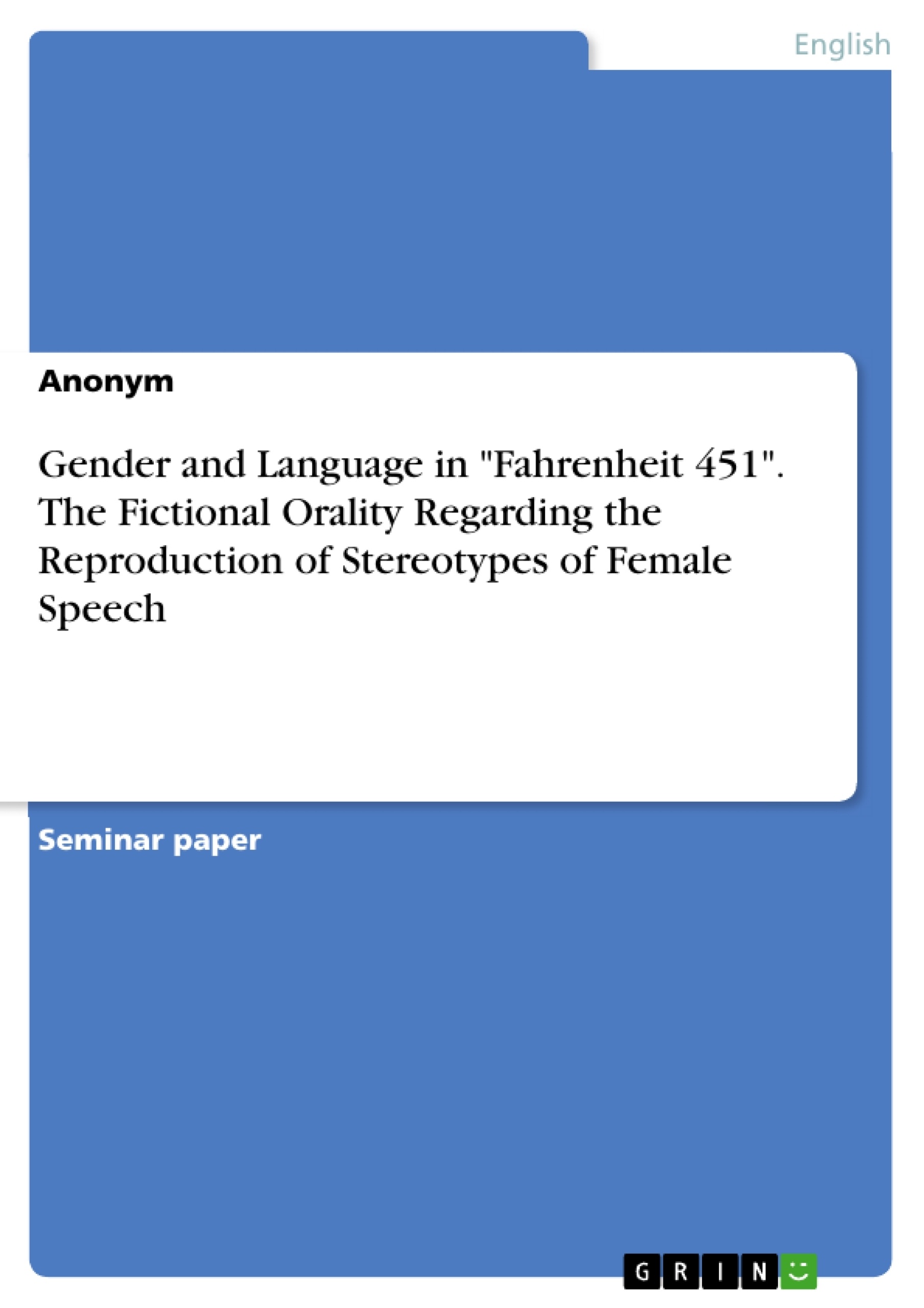This term paper, discussing Ray Bradbury's "Fahrenheit 451", aims at verifying or falsifying the hypothesis "In terms of linguistic gender stereotypes, the represented utterances of Clarisse are less stereotypical than the ones of Mildred." The author does so by analysing linguistic forms that support linguistic prejudices regarding women in a hybrid approach, which combines quantitative and qualitative aspects.
The hypothesis is to be regarded as verified if less than half of the stereotypes taken into consideration is reproduced more often in the direct speech of Clarisse. This analysis is interdisciplinary by the result of considering the branches sociolinguistics and stylistics. The analysis of the fictional orality reveals how linguistic stereotypes contribute to the portrayal of both characters and the instances of deeper meaning in this novel. Moreover, it shows to a certain degree, in how far this novel upholds the preservation of language-related clichés. Indicated stereotypical aspects of the novel can be a basis for critical questions and reflections on language-related gender stereotypes in literature, advertisement and media. Furthermore, the preparation of the examination results in an analytical framework for literary texts.
This paper starts off by, first of all, explaining the sociolinguistic perspective on linguistic gender differences to provide a clear comprehension of stereotypes, their significance, the deficits of early research on this variation and the complexity of this subject. Subsequently, the corpora's composition is illustrated and significant results of the application of the framework of analysis to the representations of direct speech of both characters are displayed. The next chapter then includes an in-depth examination of a specific part of the novel to obtain more comprehensive information regarding the contribution of representations of linguistic clichés to literary functions and a comparison of the findings. Finally, explanations for the analysis results are considered in the final chapter to justify their reliability and increase the understanding of the influences of linguistic assumptions on this novel.
Inhaltsverzeichnis (Table of Contents)
- Introduction
- The Theoretical Background of the Analysis
- The Sociolinguistic Perspective on Female Language Use
- Stereotypes and Relevant Linguistic Forms of Female Language Use
- Relevant Aspects of Stylistics: Concepts and Methodology
- Analysis of the Fictional Speech in Fahrenheit 451 regarding the Reproduction of Stereotypes regarding Female Speech
- Composition of the Corpora and Selection of the Sentences for the Elaborated Analyses
- Analysis of the Fictional Orality of the Relevant Characters
- Analysis of the Direct Speech of Clarisse
- Analysis of the Direct Speech of Mildred
- Elaborated Analysis of a Specific Part of Direct Speech of the Relevant Characters
- Elaborated Analysis of an Excerpt of the Direct Speech of Clarisse
- Elaborated Analysis of an Excerpt of the Direct Speech of Mildred
- Comparison of the Results of the Analyses
- Interpretation of the Results
Zielsetzung und Themenschwerpunkte (Objectives and Key Themes)
This term paper aims to analyse the fictional orality of Clarisse and Mildred in Ray Bradbury's Fahrenheit 451 to verify or falsify the hypothesis that Clarisse's speech is less stereotypical than Mildred's, in terms of linguistic gender stereotypes. The analysis will utilise a hybrid approach that combines quantitative and qualitative aspects, drawing on the disciplines of sociolinguistics and stylistics.
- Examining how linguistic stereotypes contribute to the portrayal of Clarisse and Mildred in Fahrenheit 451.
- Determining whether the novel reinforces language-related clichés about female speech.
- Exploring the relevance of this analysis for English as a Foreign Language (EFL) contexts and the role of gender stereotypes in literature, advertising, and media.
- Developing an analytical framework for literary texts that can be applied to other works.
- Providing a deeper understanding of the influence of linguistic assumptions on literary representations.
Zusammenfassung der Kapitel (Chapter Summaries)
The first chapter introduces the topic of gender stereotypes and their impact on the slow progress towards gender equality. It highlights the persistence of these stereotypes in contemporary society and the role of language in perpetuating them. The chapter sets out the hypothesis that Clarisse's speech in Fahrenheit 451 is less stereotypical than Mildred's.
Chapter two provides the theoretical background for the analysis, examining the sociolinguistic perspective on female language use and the relevant linguistic stereotypes. The chapter also discusses the methodology of stylistics and its relevance to the analysis.
Chapter three details the composition of the corpora and presents the results of applying the analytical framework to the direct speech of Clarisse and Mildred. It includes an in-depth examination of a specific part of the novel to explore the contribution of linguistic clichés to literary functions and compares the findings.
Schlüsselwörter (Keywords)
The primary focus of this paper is on the analysis of linguistic gender stereotypes in the fictional orality of Fahrenheit 451. The key terms and concepts include: gender stereotypes, female language use, sociolinguistics, stylistics, fictional orality, direct speech, Clarisse, Mildred, Fahrenheit 451, Ray Bradbury, and EFL contexts. The analysis aims to contribute to a deeper understanding of the role of language in perpetuating and challenging gender stereotypes in literature and beyond.
- Quote paper
- Anonym (Author), 2020, Gender and Language in "Fahrenheit 451". The Fictional Orality Regarding the Reproduction of Stereotypes of Female Speech, Munich, GRIN Verlag, https://www.grin.com/document/1338037



